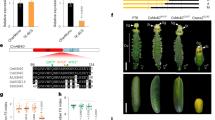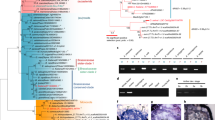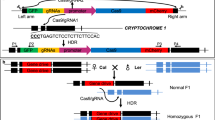Abstract
Sex determination in plants leads to the development of unisexual flowers from an originally bisexual floral meristem1,2. This mechanism results in the enhancement of outcrossing and promotes genetic variability, the consequences of which are advantageous to the evolution of a species3. In melon, sexual forms are controlled by identity of the alleles at the andromonoecious (a) and gynoecious (g) loci4. We previously showed that the a gene encodes an ethylene biosynthesis enzyme, CmACS-7, that represses stamen development in female flowers5. Here we show that the transition from male to female flowers in gynoecious lines results from epigenetic changes in the promoter of a transcription factor, CmWIP1. This natural and heritable epigenetic change resulted from the insertion of a transposon, which is required for initiation and maintenance of the spreading of DNA methylation to the CmWIP1 promoter. Expression of CmWIP1 leads to carpel abortion, resulting in the development of unisexual male flowers. Moreover, we show that CmWIP1 indirectly represses the expression of the andromonoecious gene, CmACS-7, to allow stamen development. Together our data indicate a model in which CmACS-7 and CmWIP1 interact to control the development of male, female and hermaphrodite flowers in melon.
This is a preview of subscription content, access via your institution
Access options
Subscribe to this journal
Receive 51 print issues and online access
$199.00 per year
only $3.90 per issue
Buy this article
- Purchase on Springer Link
- Instant access to full article PDF
Prices may be subject to local taxes which are calculated during checkout




Similar content being viewed by others
References
Tanurdzic, M. & Banks, J. A. Sex-determining mechanisms in land plants. Plant Cell 16 (suppl). S61–S71 (2004)
Dellaporta, S. L. & Calderon-Urrea, A. Sex determination in flowering plants. Plant Cell 5, 1241–1251 (1993)
Dellaporta, S. L. & Calderon-Urrea, A. The sex determination process in maize. Science 266, 1501–1505 (1994)
Poole, C. F. & Grimball, P. C. Inheritance of new sex forms in Cucumis melo L. J. Hered. 30, 21–25 (1939)
Boualem, A. et al. A conserved mutation in an ethylene biosynthesis enzyme leads to andromonoecy in melons. Science 321, 836–838 (2008)
Ainsworth, C., Parker, J. & Buchanan-Wollaston, V. Sex determination in plants. Curr. Top. Dev. Biol. 38, 167–223 (1998)
Kempken, F. & Windhofer, F. The hAT family: a versatile transposon group common to plants, fungi, animals, and man. Chromosoma 110, 1–9 (2001)
Slotkin, R. K. & Martienssen, R. Transposable elements and the epigenetic regulation of the genome. Nature Rev. Genet. 8, 272–285 (2007)
Weil, C. & Martienssen, R. Epigenetic interactions between transposons and genes: lessons from plants. Curr. Opin. Genet. Dev. 18, 188–192 (2008)
Arnaud, P., Goubely, C., Pelissier, T. & Deragon, J. M. SINE retroposons can be used in vivo as nucleation centers for de novo methylation. Mol. Cell. Biol. 20, 3434–3441 (2000)
Sun, F. L. et al. cis-Acting determinants of heterochromatin formation on Drosophila melanogaster chromosome four. Mol. Cell. Biol. 24, 8210–8220 (2004)
Martienssen, R. A., Doerge, R. W. & Colot, V. Epigenomic mapping in Arabidopsis using tiling microarrays. Chromosome Res. 13, 299–308 (2005)
Saze, H. & Kakutani, T. Heritable epigenetic mutation of a transposon-flanked Arabidopsis gene due to lack of the chromatin-remodeling factor DDM1. EMBO J. 26, 3641–3652 (2007)
Christman, J. K., Sheikhnejad, G., Marasco, C. J. & Sufrin, J. R. 5-Methyl-2′- deoxycytidine in single-stranded DNA can act in cis to signal de novo DNA methylation. Proc. Natl Acad. Sci. USA 92, 7347–7351 (1995)
Jones, P. A. & Takai, D. The role of DNA methylation in mammalian epigenetics. Science 293, 1068–1070 (2001)
Sagasser, M., Lu, G. H., Hahlbrock, K. & Weisshaar, B. A. thaliana TRANSPARENT TESTA 1 is involved in seed coat development and defines the WIP subfamily of plant zinc finger proteins. Genes Dev. 16, 138–149 (2002)
Crawford, B. C., Ditta, G. & Yanofsky, M. F. The NTT gene is required for transmitting-tract development in carpels of Arabidopsis thaliana . Curr. Biol. 17, 1101–1108 (2007)
Bai, S. L. et al. Developmental analyses reveal early arrests of the spore-bearing parts of reproductive organs in unisexual flowers of cucumber (Cucumis sativus L.). Planta 220, 230–240 (2004)
Cubas, P., Vincent, C. & Coen, E. An epigenetic mutation responsible for natural variation in floral symmetry. Nature 401, 157–161 (1999)
Kalisz, S. & Purugganan, M. D. Epialleles via DNA methylation: consequences for plant evolution. Trends Ecol. Evol. 19, 309–314 (2004)
Manning, K. et al. A naturally occurring epigenetic mutation in a gene encoding an SBP-box transcription factor inhibits tomato fruit ripening. Nature Genet. 38, 948–952 (2006)
Bendahmane, A., Kanyuka, K. & Baulcombe, D. C. The Rx gene from potato controls separate virus resistance and cell death responses. Plant Cell 11, 781–792 (1999)
Pontier, D. et al. Reinforcement of silencing at transposons and highly repeated sequences requires the concerted action of two distinct RNA polymerases IV in Arabidopsis . Genes Dev. 19, 2030–2040 (2005)
Triques, K. et al. Characterization of Arabidopsis thaliana mismatch specific endonucleases: application to mutation discovery by TILLING in pea. Plant J. 51, 1116–1125 (2007)
Staden, R., Beal, K. F. & Bonfield, J. K. The Staden package, 1998. Methods Mol. Biol. 132, 115–130 (2000)
Hetzl, J., Foerster, A. M., Raidl, G. & Scheid, M. O. CyMATE: a new tool for methylation analysis of plant genomic DNA after bisulphite sequencing. Plant J. 51, 526–536 (2007)
Livak, K. J. & Schmittgen, T. D. Analysis of relative gene expression data using real-time quantitative PCR and the 2-ΔΔC T method. Methods 25, 402–408 (2001)
Acknowledgements
We thank D. Bradley, M. Purugganan, P. Laufs, J. C. Palauqui and colleagues from Unité de Recherche en Génomique Végétale (URGV) for discussions and comments on the manuscript, and F. Teixeira and V. Colot for helpful assistance on DNA methylation assays. This work was supported by GAP department in INRA and by a grant from Genopole (A.M.).
Author Contributions A.Be., C.D. and M.P. initiated the project. A.M., C.D. and A.Be. designed the experiments. A.M., C.T., A.Bo., M.R., R.F. and H.M. performed the experiments, for which the data were analysed by A.M., C.D. and A.Be. A.M. and A.Be. wrote the paper, which was commented on and improved by all the authors.
Author information
Authors and Affiliations
Corresponding author
Supplementary information
Supplementary Information
This file contains Supplementary Figures S1-S7 with Legends, Supplementary Tables S1-S3, a Supplementary Discussion and Supplementary References. (PDF 846 kb)
Rights and permissions
About this article
Cite this article
Martin, A., Troadec, C., Boualem, A. et al. A transposon-induced epigenetic change leads to sex determination in melon. Nature 461, 1135–1138 (2009). https://doi.org/10.1038/nature08498
Received:
Accepted:
Issue Date:
DOI: https://doi.org/10.1038/nature08498
This article is cited by
-
Reciprocal expression of MADS-box genes and DNA methylation reconfiguration initiate bisexual cones in spruce
Communications Biology (2024)
-
Gender specific SNP markers in Coscinium fenestratum (Gaertn.) Colebr. for resource augmentation
Molecular Biology Reports (2024)
-
Epigenetics: Toward improving crop disease resistance and agronomic characteristics
Plant Biotechnology Reports (2024)
-
Mechanism of hybrid seed production in cucurbitaceous vegetables
Euphytica (2024)
-
Applications of CRISPR/Cas genome editing in economically important fruit crops: recent advances and future directions
Molecular Horticulture (2023)
Comments
By submitting a comment you agree to abide by our Terms and Community Guidelines. If you find something abusive or that does not comply with our terms or guidelines please flag it as inappropriate.



